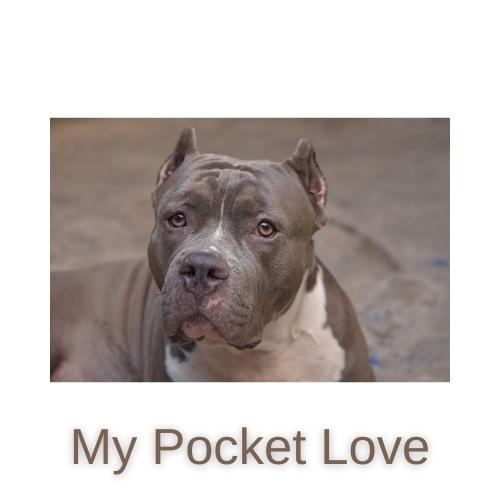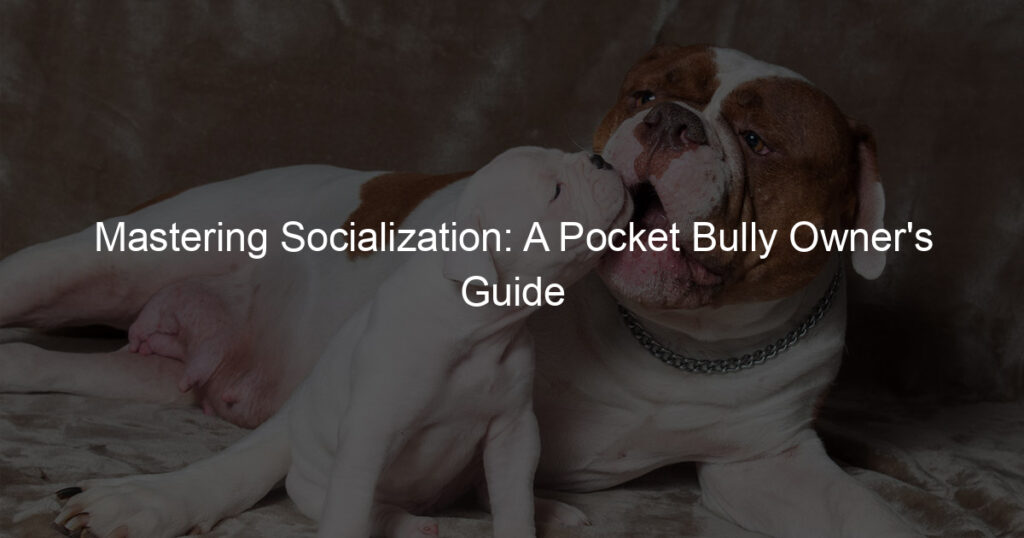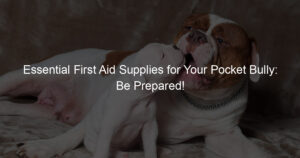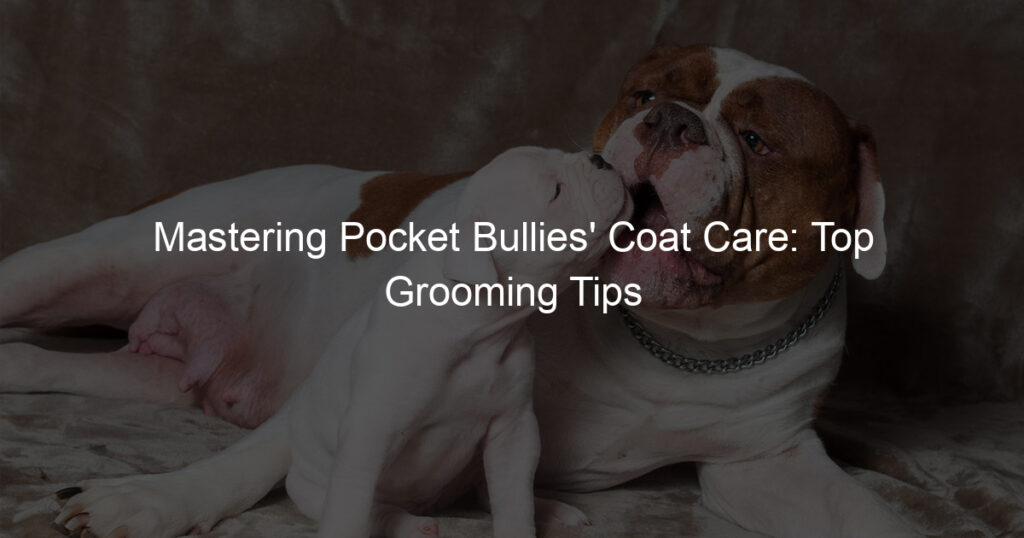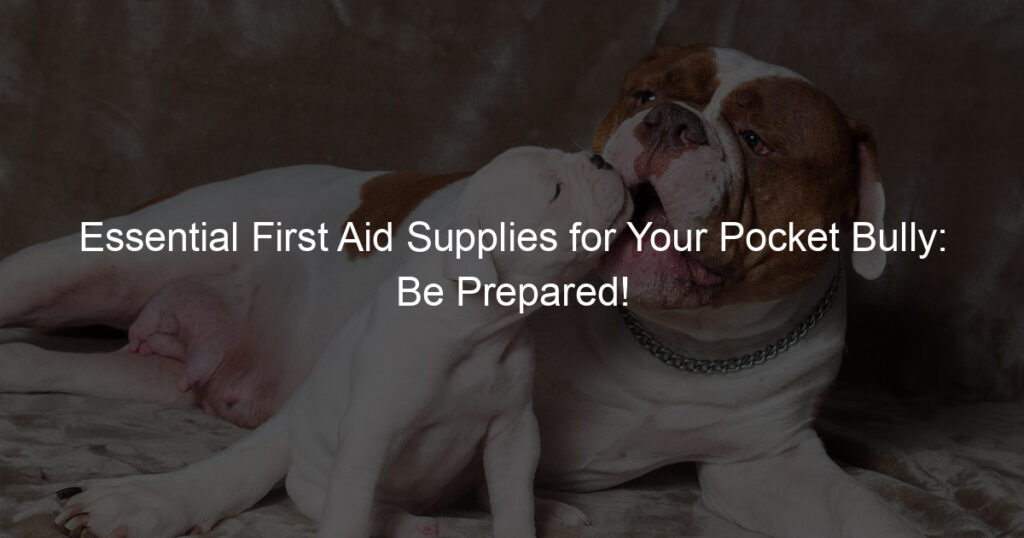
Introduction to Pocket Bullies Socialization
When it comes to raising a happy and well-adjusted Pocket Bully, one of the most crucial aspects to focus on is socialization. This process is not only about teaching your Pocket Bully to behave around other dogs and people but also about helping them feel comfortable and confident in a variety of environments and situations.
- Understanding the Importance of Socialization
Socialization is a critical part of any dog’s life, including Pocket Bullies. It’s the process of exposing your dog to new experiences, people, environments, and other animals in a positive way. The goal is to help your Pocket Bully become a well-rounded, confident, and friendly dog. Without proper socialization, your Pocket Bully may become fearful or aggressive. According to statistics, dogs that are not properly socialized are more likely to develop behavioral problems and are more likely to be surrendered to shelters.
- Defining Socialization for Pocket Bullies
For Pocket Bullies, socialization means more than just meeting other dogs. It’s about introducing them to a variety of experiences, sounds, smells, and sights in a controlled and positive way. This could include everything from meeting new people and animals, to experiencing different environments like parks, city streets, and the vet’s office. The aim is to help your Pocket Bully feel comfortable and safe in these situations, reducing the likelihood of fear or aggression.
Remember, socialization should start at a young age and continue throughout your Pocket Bully’s life. It’s a continuous process that requires patience and consistency. But the rewards – a happy, confident, and well-behaved Pocket Bully – are well worth the effort.
The Basics of Socializing Pocket Bullies
Socializing your Pocket Bully is an essential part of their upbringing. It helps them to develop a friendly and well-behaved demeanor. Let’s delve into when you should start this process and why it’s beneficial.
When to Start Socializing Your Pocket Bully
Knowing when to start socializing your Pocket Bully is crucial. It’s a process that should ideally begin at a young age. Let’s explore this in more detail.
- Understanding the ideal age for socialization
- Early socialization benefits
The best time to start socializing your Pocket Bully is when they are between 3 to 12 weeks old. This period is often referred to as the ‘socialization window’. During this time, puppies are most receptive to new experiences and environments. Starting socialization during this window can help shape your Pocket Bully’s behavior in a positive way.
There are numerous benefits to early socialization. Firstly, it helps your Pocket Bully become comfortable with different people, animals, and environments. This can reduce fear and anxiety in unfamiliar situations. Secondly, early socialization can help prevent behavioral problems in the future. Studies show that dogs that are well socialized from a young age are less likely to exhibit aggressive behavior. Lastly, it can also enhance your bond with your Pocket Bully, making them more trusting and affectionate towards you.
In conclusion, starting the socialization process early is key to raising a well-adjusted and friendly Pocket Bully. It not only helps them become more comfortable in various situations, but it can also prevent future behavioral issues and strengthen your bond with them.
How to Socialize Your Pocket Bully
Proper socialization is a crucial part of raising a well-behaved and happy Pocket Bully. It involves introducing your pet to new environments, meeting new people and animals, and encouraging positive interactions. Let’s delve into these aspects.
-
Introducing New Environments
Exposing your Pocket Bully to different environments is a great way to build their confidence. Start by taking them to quiet places like a local park, then gradually introduce busier locations like pet stores or dog-friendly cafes. Remember to keep these experiences positive. For instance, you can reward your pet with treats or praises when they behave well in these new environments.
-
Meeting New People and Animals
Meeting new people and animals is another essential part of socializing your Pocket Bully. This helps them understand that not all strangers are threats. Start by introducing them to friends and family, then gradually expose them to other pets and animals. Always supervise these interactions to ensure they remain positive and safe.
-
Encouraging Positive Interactions
Encouraging positive interactions involves rewarding your Pocket Bully when they behave well around others. This could be when they play nicely with another pet or when they remain calm around strangers. Positive reinforcement like treats, praises, or toys can be very effective in promoting good behavior.
Remember, socializing your Pocket Bully is a gradual process. It requires patience and consistency. But with time, your pet will learn to be comfortable and well-behaved in various situations, making them a joy to be around.
Pocket Bullies Behavior Training
Training your Pocket Bully is a crucial part of their upbringing. It helps them become well-behaved and sociable pets. In this section, we will explore some effective training techniques that can help shape your Pocket Bully’s behavior.
Training Techniques for Pocket Bullies
There are several training techniques that can be used for Pocket Bullies. However, the most effective ones are those that focus on positive reinforcement, consistency, and patience. Let’s delve into each of these techniques:
- Positive Reinforcement
- Consistency in Training
- Patience and Understanding
Positive reinforcement is a method where you reward your Pocket Bully for displaying good behavior. This can be through treats, praises, or petting. According to a study by the American Kennel Club, dogs trained using positive reinforcement are more likely to repeat good behavior. For instance, if your Pocket Bully sits when told to, reward them with a treat. They will associate sitting on command with a positive outcome, encouraging them to repeat the behavior.
Consistency is key when training your Pocket Bully. This means sticking to the same commands and rules, and ensuring all family members do the same. For example, if you are training your dog not to jump on the couch, everyone in the house should follow this rule. Inconsistency can confuse your dog and make training more difficult.
Training a Pocket Bully, like any other dog, requires patience and understanding. Remember, your pet is not going to understand everything immediately. It’s important to remain calm and patient during training sessions. If they make a mistake, don’t punish them harshly. Instead, guide them gently towards the correct behavior. Understanding your dog’s unique personality and learning style can also make training more effective.
Remember, training your Pocket Bully is not a one-time event but a continuous process. It requires time, effort, and a lot of love. But the rewards of having a well-behaved and sociable pet are definitely worth it!
Common Behavior Issues and Solutions
When it comes to training Pocket Bullies, it’s important to understand some of the common behavior issues these dogs may exhibit. By identifying these issues and knowing how to address them, you can help your Pocket Bully become a well-behaved and sociable pet. Let’s explore three common behavior issues: Aggression, Anxiety, and Stubbornness.
- Aggression
- Anxiety
- Stubbornness
Aggression in Pocket Bullies can manifest as growling, snarling, or even biting. This behavior often stems from fear or a lack of socialization. It’s crucial to introduce your Pocket Bully to a variety of people, animals, and environments at a young age to prevent aggressive tendencies. Positive reinforcement, such as treats and praise, can be used to reward non-aggressive behavior.
Anxiety is another common issue in Pocket Bullies. Signs of anxiety can include excessive barking, pacing, or destructive behavior. To help your dog manage anxiety, maintain a consistent routine and provide plenty of physical and mental stimulation. Training techniques that promote calm behavior, such as sit and stay commands, can also be beneficial.
Stubbornness can be a challenging behavior issue in Pocket Bullies. These dogs are intelligent and strong-willed, which can sometimes lead to stubborn behavior. Consistency in training is key to overcoming this issue. Be patient, and remember that every dog learns at their own pace. Rewarding your dog for following commands can also help to motivate them.
In conclusion, understanding and addressing these common behavior issues can greatly improve your Pocket Bully’s social skills. Remember, patience and consistency are key in any training process. With the right approach, your Pocket Bully can become a well-behaved and sociable member of your family.
Proper Socialization for Pocket Bullies
One of the most critical aspects of raising a Pocket Bully is ensuring they are properly socialized. This process involves introducing them to a variety of experiences, people, and environments in a safe and controlled manner. This helps them grow into well-rounded, confident, and friendly dogs.
Creating a Safe and Comfortable Environment
Creating a safe and comfortable environment is the first step in socializing your Pocket Bully. This involves two key aspects:
- Importance of a safe space
- Comforting your Pocket Bully during socialization
A safe space is a place where your Pocket Bully feels secure and comfortable. This could be a specific room in your house, a crate, or even a particular spot in your yard. This space should be free from loud noises, other pets, and anything else that might stress or scare your dog. A safe space is essential because it gives your Pocket Bully a place to retreat to if they ever feel overwhelmed or scared.
Comforting your Pocket Bully during socialization is crucial. This involves being there for them, providing reassurance, and rewarding them for positive behavior. For example, if your Pocket Bully is meeting a new person or dog, stay by their side and offer praise and treats when they behave well. This helps them associate new experiences with positive outcomes, making them more likely to be comfortable in similar situations in the future.
In conclusion, creating a safe and comfortable environment is a fundamental part of socializing your Pocket Bully. By providing a safe space and comforting your dog during new experiences, you can help them become a confident and friendly pet.
Dealing with Negative Experiences
As a Pocket Bully owner, it’s crucial to understand how to deal with negative experiences that your pet may encounter. This involves understanding their fears and helping them overcome these experiences. Let’s delve into these two important aspects.
- Understanding your Pocket Bully’s fear
- Helping your Pocket Bully overcome negative experiences
Every Pocket Bully, like any other dog, has its own set of fears. These fears may stem from a variety of sources, such as loud noises, unfamiliar environments, or even specific objects. It’s essential to identify these fears to help your pet cope better. For instance, if your Pocket Bully is scared of loud noises, you might notice them shaking or hiding during a thunderstorm or fireworks display. Understanding these fears is the first step towards helping your Pocket Bully overcome them.
Once you’ve identified your Pocket Bully’s fears, the next step is to help them overcome these negative experiences. This can be achieved through gradual exposure and positive reinforcement. For example, if your Pocket Bully is afraid of loud noises, you can start by playing soft sounds and gradually increase the volume over time, rewarding them with treats or praise each time they remain calm. This process, known as desensitization, can help your Pocket Bully associate previously scary experiences with positive outcomes.
In conclusion, understanding and helping your Pocket Bully overcome their fears is a crucial part of their socialization process. It not only helps them feel more comfortable in different situations but also strengthens your bond with them. Remember, patience and consistency are key in this process.
Training Pocket Bullies for Better Social Skills
Training your Pocket Bully for better social skills is an essential part of their upbringing. It not only helps them interact better with other animals and humans, but also boosts their confidence and overall behavior. Let’s delve into how you can build confidence in your Pocket Bully.
Building Confidence in Your Pocket Bully
Building confidence in your Pocket Bully involves two main strategies: encouraging independence and reinforcing positive behavior. Both these strategies work hand in hand to ensure your Pocket Bully grows into a well-rounded and sociable pet.
- Encouraging Independence
- Reinforcing Positive Behavior
Encouraging independence in your Pocket Bully is the first step towards building their confidence. This involves allowing them to explore their surroundings and make decisions on their own. For example, let them choose their favorite toy or decide where they want to sleep. This not only helps them become more confident, but also fosters a sense of security and trust.
Reinforcing positive behavior is another crucial aspect of building confidence in your Pocket Bully. This involves rewarding them for good behavior and ignoring or redirecting bad behavior. For instance, if your Pocket Bully behaves well during a visit to the vet, reward them with a treat or their favorite toy. This will encourage them to repeat the behavior in the future.
Remember, building confidence in your Pocket Bully is a gradual process that requires patience and consistency. But with the right approach, you can help your Pocket Bully develop better social skills and become a confident and well-behaved pet.
Teaching Your Pocket Bully to Interact with Others
One of the most important aspects of socializing your Pocket Bully is teaching them how to interact with others. This includes both other animals and humans. Here are some key steps to follow:
- Introducing other animals
- Teaching proper play behavior
Introducing your Pocket Bully to other animals is a crucial part of their socialization process. Start by introducing them to calm and well-behaved animals. Always supervise these interactions and reward your Pocket Bully for positive behavior. It’s important to remember that each animal has its own personality and comfort level. Therefore, be patient and give your Pocket Bully plenty of time to adjust.
Teaching your Pocket Bully proper play behavior is another essential step. This involves teaching them not to bite or play too roughly. Start by allowing them to play with soft toys and rewarding them when they play gently. If they start to play too aggressively, redirect their attention to a more appropriate activity. Remember, consistency is key in teaching proper play behavior.
By following these steps, you can help your Pocket Bully develop better social skills and become a well-behaved member of your family.
Pocket Bullies Upbringing and Care
One of the key aspects of raising a healthy and well-behaved Pocket Bully is ensuring they get regular exercise. Exercise not only keeps your Pocket Bully in good physical shape, but it also helps them to stay mentally stimulated and happy.
Importance of Regular Exercise
Regular exercise is crucial for your Pocket Bully’s overall health and well-being. It helps to prevent obesity, keeps their muscles strong, and provides them with an outlet for their energy. Let’s delve into the benefits of exercise and some recommended routines for your Pocket Bully.
- Benefits of exercise for Pocket Bullies
- Recommended exercise routines
- Short walks: Two 15-minute walks per day can be a good starting point.
- Playtime: Games like fetch or tug-of-war can provide both physical exercise and mental stimulation.
- Training sessions: Teaching your Pocket Bully new tricks or commands can keep their mind sharp.
- Agility training: Setting up an agility course in your backyard can provide a fun and challenging workout for your Pocket Bully.
Exercise offers numerous benefits for your Pocket Bully. Firstly, it helps to maintain a healthy weight, reducing the risk of obesity-related health issues. Secondly, it strengthens their muscles and improves cardiovascular health. Exercise also helps to reduce behavioral problems by providing an outlet for energy and reducing boredom. Lastly, regular exercise can improve your Pocket Bully’s mood and overall quality of life.
When it comes to exercise routines for your Pocket Bully, variety is key. This breed enjoys both physical and mental stimulation. Some recommended exercises include:
Remember, the key to a successful exercise routine for your Pocket Bully is consistency and variety. Always monitor your pet during exercise to ensure they are not overexerting themselves and ensure they have access to fresh water at all times.
Proper Nutrition for Pocket Bullies
When it comes to the upbringing and care of Pocket Bullies, one aspect that cannot be overlooked is their nutrition. Just like humans, these adorable creatures require a balanced diet to stay healthy and active. Let’s delve into understanding their dietary needs and how to choose the right food for them.
- Understanding your Pocket Bully’s dietary needs
Pocket Bullies, despite their small size, have a robust and muscular build. They require a diet rich in proteins to maintain their muscle mass and energy levels. According to pet nutrition experts, an adult Pocket Bully’s diet should consist of approximately 40% protein. They also need a good amount of carbohydrates for energy, and fats for a shiny coat and healthy skin. Vitamins and minerals are essential too, for overall health and well-being.
It’s also important to note that the dietary needs of a Pocket Bully may vary based on their age, size, and activity level. Puppies require more calories as they are growing, while older dogs may need fewer calories but more fiber and certain nutrients. Always consult with a vet to understand the specific dietary needs of your Pocket Bully.
- Choosing the right food for your Pocket Bully
When selecting food for your Pocket Bully, look for high-quality dog food that lists a source of animal protein, like chicken or beef, as the first ingredient. Avoid foods that contain fillers like corn and wheat, as they offer little nutritional value. Instead, opt for foods with wholesome grains, fruits, and vegetables.
Consider your Pocket Bully’s age, size, and activity level when determining the right portion sizes. Overfeeding can lead to obesity, which can cause a host of health problems. On the other hand, underfeeding can lead to malnutrition. If you’re unsure about portion sizes, it’s best to consult with a vet.
Remember, every dog is unique, and what works for one may not work for another. It may take some trial and error to find the best food for your Pocket Bully. But with patience and guidance from a vet, you can ensure your Pocket Bully gets the nutrition they need to thrive.
| Dietary Component | Approximate Percentage in Diet |
|---|---|
| Protein | 40% |
| Carbohydrates | 30% |
| Fats | 20% |
| Vitamins and Minerals | 10% |
In conclusion, proper nutrition is a key aspect of Pocket Bullies’ upbringing and care. By understanding their dietary needs and choosing the right food, you can ensure your Pocket Bully stays healthy and happy.
Conclusion: Pocket Bullies Socialization Tips
In wrapping up our discussion on socializing Pocket Bullies, we’ve learned a great deal about the importance of proper training and care for these unique pets. Let’s take a moment to recap some of the key points we’ve covered.
- Recap of socialization techniques: We’ve explored various techniques that can help your Pocket Bully become more sociable. These include early exposure to different environments, people, and other animals. We’ve also discussed the importance of positive reinforcement in training, such as rewarding good behavior with treats and praise. Remember, the goal is to make your Pocket Bully feel comfortable and safe in various social situations.
- Importance of patience and consistency: Socializing a Pocket Bully, like any other dog, requires a great deal of patience and consistency. It’s not something that can be achieved overnight. It’s a gradual process that requires a consistent approach. You need to be patient and persistent, even when progress seems slow. Remember, every small step your Pocket Bully takes towards becoming more sociable is a big victory.
In conclusion, socializing your Pocket Bully is a crucial aspect of their upbringing and care. It not only helps them become well-behaved pets but also contributes to their overall well-being. With patience, consistency, and the right techniques, you can help your Pocket Bully become a sociable and friendly pet.
